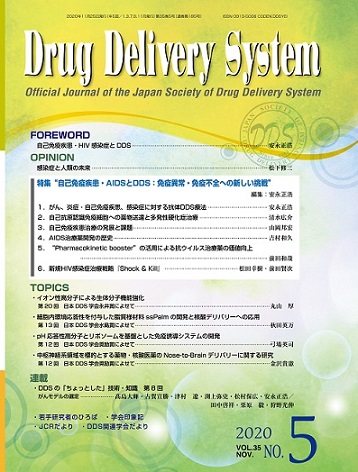Volume 35, Issue 5
DDS for autoimmune disease and AIDS: a new challenge against immunological abnormality and immunodeficiency
Displaying 1-16 of 16 articles from this issue
- |<
- <
- 1
- >
- >|
“DDS for autoimmune disease and AIDS: a new challenge against immunological abnormality and immunodeficiency” Editor:Masahiro Yasunaga
-
2020Volume 35Issue 5 Pages 353
Published: November 25, 2020
Released on J-STAGE: February 25, 2021
Download PDF (192K) -
2020Volume 35Issue 5 Pages 354
Published: November 25, 2020
Released on J-STAGE: February 25, 2021
Download PDF (166K) -
2020Volume 35Issue 5 Pages 356-366
Published: November 25, 2020
Released on J-STAGE: February 25, 2021
Download PDF (1701K) -
2020Volume 35Issue 5 Pages 367-375
Published: November 25, 2020
Released on J-STAGE: February 25, 2021
Download PDF (941K) -
2020Volume 35Issue 5 Pages 376-383
Published: November 25, 2020
Released on J-STAGE: February 25, 2021
Download PDF (647K) -
2020Volume 35Issue 5 Pages 384-393
Published: November 25, 2020
Released on J-STAGE: February 25, 2021
Download PDF (791K) -
2020Volume 35Issue 5 Pages 394-400
Published: November 25, 2020
Released on J-STAGE: February 25, 2021
Download PDF (662K) -
2020Volume 35Issue 5 Pages 401-408
Published: November 25, 2020
Released on J-STAGE: February 25, 2021
Download PDF (856K)
TOPICS
-
2020Volume 35Issue 5 Pages 410-416
Published: November 25, 2020
Released on J-STAGE: February 25, 2021
Download PDF (992K) -
2020Volume 35Issue 5 Pages 417-425
Published: November 25, 2020
Released on J-STAGE: February 25, 2021
Download PDF (1017K) -
2020Volume 35Issue 5 Pages 426-433
Published: November 25, 2020
Released on J-STAGE: February 25, 2021
Download PDF (1160K) -
2020Volume 35Issue 5 Pages 434-441
Published: November 25, 2020
Released on J-STAGE: February 25, 2021
Download PDF (1676K)
[Serial]Tips for your DDS research
-
2020Volume 35Issue 5 Pages 443-447
Published: November 25, 2020
Released on J-STAGE: February 25, 2021
Download PDF (1325K)
“Young square”(mini review)
-
2020Volume 35Issue 5 Pages 448-449
Published: November 25, 2020
Released on J-STAGE: February 25, 2021
Download PDF (337K)
Meeting Reports
-
2020Volume 35Issue 5 Pages 450-451
Published: November 25, 2020
Released on J-STAGE: February 25, 2021
Download PDF (603K) -
2020Volume 35Issue 5 Pages 452-453
Published: November 25, 2020
Released on J-STAGE: February 25, 2021
Download PDF (231K)
- |<
- <
- 1
- >
- >|
